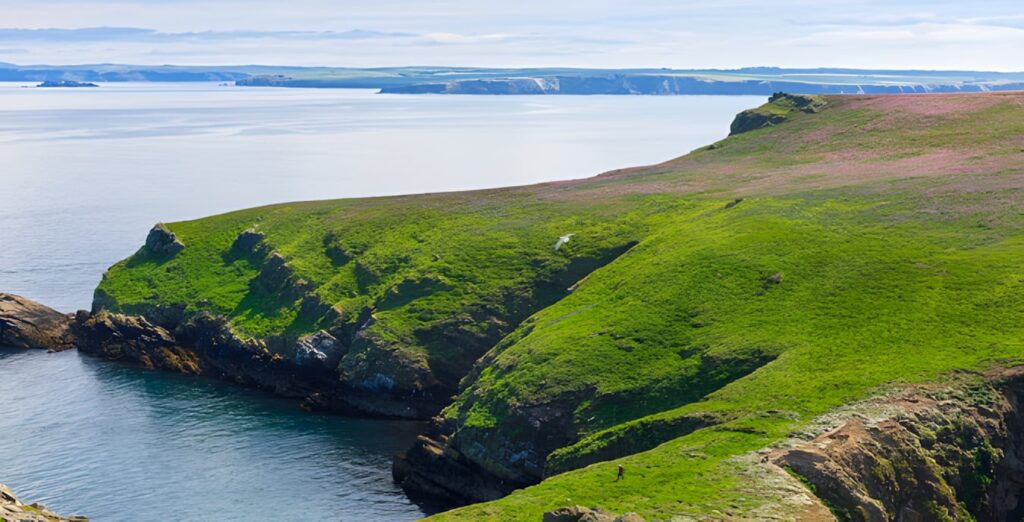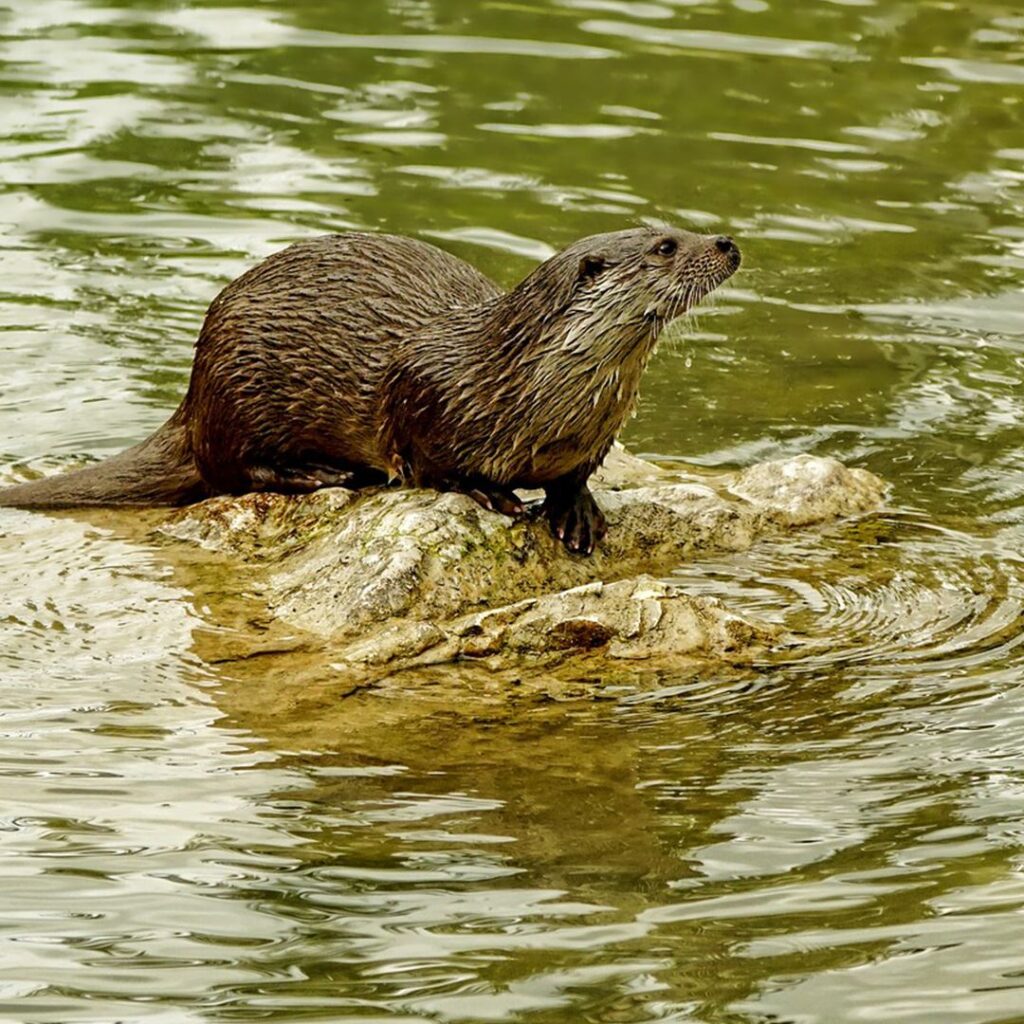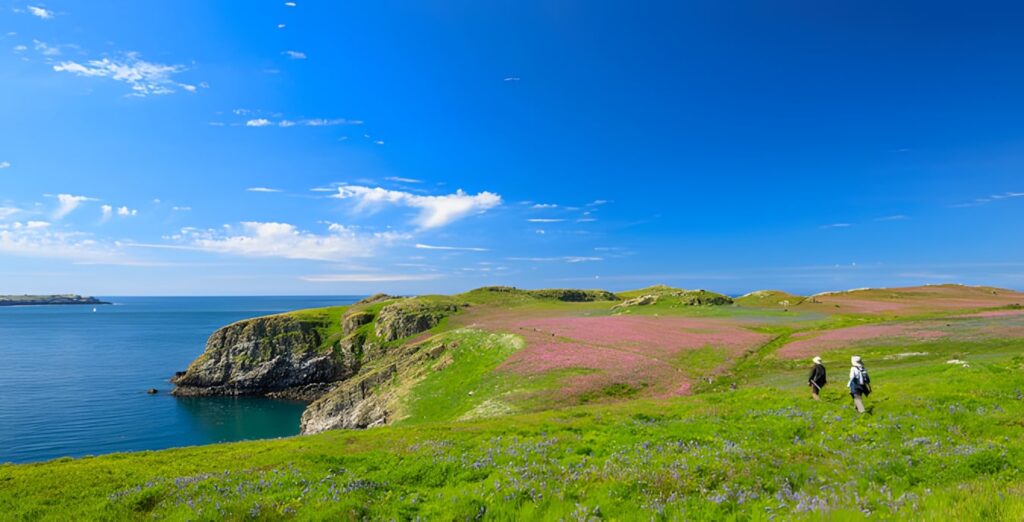Skomer Island:
Paradise on Pembrokeshire's coast
Visit Skomer Island
If you want to spend some time in Pembrokeshire to enjoy Skomer, or any of the other wonders of nature that are so abundantly available in this part of the world, you may want to have a look at the accommodation provided at Rosemoor. Located in the neck of the Dale/Marloes peninsula, all of Pembrokeshire is within easy reach from there, and there is the added bonus of the Rosemoor Nature Reserve directly on your doorstep!
Skomer Island lies just to the South-West of the Marloes Peninsula of Pembrokeshire. Time, the continuous erosion by nature’s forces and the relative movement of sea level to landmasses have turned Skomer into what it is now: an island effectively cut off from the rest of Pembrokeshire by Jack Sound, a narrow stretch of water, renowned for its strong tidal currents. The island’s isolation has meant that mammalian ground predators such as rats, cats, dogs and foxes are absent. This is one of the major reasons for the island’s importance as a breeding ground for burrow nesting seabirds. Man is only present in the form of daytime visitors (with only a small number allowed to stay the night in self-catering accommodation run by the Wildlife Trust South & West Wales), and the warden and students of Skomer’s unique wildlife. All combined Skomer truly is a jewel in Pembrokeshire’s crown, a paradise for birds and other wildlife and bird-and-wildlife-loving man alike.
Rachel Mullett’s father was stranded on Skokholm when war was declared and she grew up on a farm on the Dale peninsula. Skomer is her favourite island and she is crazy about puffins. Visit Pembrokeshire Moments and have a look at her photographic gifts and souvenirs, in case you would want to take a bit of Pembrokeshire home with you.

Skomer Island: National Nature Reserve of international importance
The 730-or-so acres (292 hectares) of Skomer offer extremely important breeding grounds for a great variety of seabirds. This fact is recognised in Skomer having been made a National Nature Reserve, a Site of Special Scientific Interest and a Special Protection Area under European Law.
The island is managed by the Wildlife Trust South & West Wales under a lease from the owners, the Countryside Council for Wales, which is now in its third 21-year term.
Skomer is probably the most important breeding site of Manx Shearwaters in the world, with an estimated population of 165,000 pairs. It is difficult to find spots on the island which are not burrowed by them.
Puffins breed on Skomer in large numbers as well: approximately 6,000 pairs have been counted. Other birds present in large numbers are Guillemots, Razorbills and of course the ever present gull family: Kittiwakes, the smallest, the Lesser Black-backed Gulls, Herring Gulls and the enormously big Great Black-backed Gulls.
Great numbers of migratory birds use Skomer as a stop-over: amongst others Finches, Skylarks, Swallows, Chiffchaffs and Meadow Pipits, as well as the occasional rare bird such as the Golden Oriole, Tawny Pipit, a variety of Warblers, the Black Stork and the Frigate Bird.
Perhaps not very interesting per se but of importance for wildlife on the island nonetheless are the vast numbers of rabbits present. They were introduced around 1400 AD as a source of meat and fur. They have burrowed the island extensively, to the advantage of the Shearwaters and Puffins, which nest in burrows. Bigger species of gulls feast on the rabbits and the other interesting mammal on the island: the Skomer Vole, a subspecies of the Bank Vole. Little short-eared owls also prey on the Skomer Vole. Uncharacteristically for an owl, this subspecies hunts by day, so can most of the time readily be seen by visitors to the island.
Grey Seals are to be found breeding around Skomer every Autumn. They are outnumbered in Wales only by the colony which breeds around Ramsey Island, not too far away to the north, just off the coast at St. David’s.
Porpoises and Dolphins can be seen off Skomer almost all year round. Look for Gannnets fishing (they prefer the same fishing grounds) and try to spot the inconspicuous dorsal finns; the tidal races around the island are the best places to go.

Fauna of the Nature Reserve
The Rosemoor Nature Reserve South Wales, is inhabited by badgers (at least 2 setts are situated within the grounds), otters (difficult to see, except for their spraint which is a telltale sign of their presence) and a great variety of birds. Mallard, coot and moorhen are to be found, as are the Canada Geese, who return every year to produce their delightful fluffy yellow goslings on the islands in the Lake. Heron, cormorant, lesser black backed gulls are regular visitors, as are little grebe, pochard, golden-eye and tufted ducks. The lovely blue of a kingfisher is frequently seen as well.
Since early 2007 a pair of mute swans are in residence on the lake and have successfully raised cygnets.
Peregrine falcons have been seen breeding within sight of Rosemoor, and if you are lucky merlins can be seen hunting for prey.
In the Reserve, in the fields surrounding us and close to our house as well we very frequently see pheasants (possibly escaped from a nearby farm, but happy enough to live in the wild, or so it seems), rabbits and the more common types of birds: magpies, jackdaws, house sparrows (lots!), jays, wrens, robins, tits, woodpeckers, swallows, et cetera.
More common birds of prey – notably owls and buzzards – live off the small animals literally walking onto their dinner plates; perched on a nearby telephone pole, all they have to do is wait.

Plant Life on Skomer Island
Being as exposed as it is no trees are to be found on Skomer. In order for any other plants to survive they must be able to sustain the salt laden winds with their dessicating effect.
It is no wonder therefore that grasses (Red Fescue and Common Bent) have the upper hand. As the rabbits and Skomer Voles are an additional threat to edible plants the only ones to grow to any height are those unpalatable to these rodents.
Especially in Spring Skomer is carpeted with flowers: Bluebells as far as the eye can see, intermingled with the pink of Red Campion and Thrift and the white of Sea Campion.
Autumn brings purple heather and yellow Ragwort, the object of concerted efforts of extermination elsewhere in Britain.
Farming History
Evidence of occupation by man from the Iron Age onwards is abundant: most of Skomer is an Ancient Monument. The island is believed to have supported an Iron Age community of up to 200 people. From the 7th century on a modern field system was gradually put in place in the centre of the island, which has supported a single farm until 1950, when the island was sold and Reuben Codd, its last farmer, went to warden it from Martin’s Haven.
In the eary 1800’s a farmhouse was built in the centre of the island. It was this period that links Skomer with Rosemoor, as during the Napoleonic Wars the island (like Ramsey then and for a long time afterwards as well) was leased by John Summers and his descendants, first of Moor, later of Rosemoor in the parish of Walwyn’s Castle.
Another important man for Skomer (and one who, like the Summers in their time, made a nice living out of it) was Edward Robinson, who farmed the island from the late 1840’s. Around 1880 the tide turned for farmers as refrigerated steam ships began bringing in meat and dairy produce from overseas: never again was farming a very profitable affair on Skomer.
In 1954 a great storm badly damaged the roof of the farmhouse which, not repaired, soon caused the building to become a ruin. Recently plans were put forward to bring the farmhouse back to its former glory. Some of the outbuildings have been refurbished, and are currently in use as accommodation for visitors and volunteers working on the island.
How to get there
The island is within easy reach of the Pembrokeshire mainland. From early Spring until late Autumn daily (except Mondays) landings depart from the small harbour at Martin’s Haven on the Marloes Peninsula except when weather conditions are adverse. From 2021 trips to and around Skomer, Skokholm and Grassholm islands will be pre-bookable online. For up to date information visit Dale Sailing/Pembrokeshire Island Boat Trips. Will we miss the pre-dawn queuing at Martin’s Haven? It certainly had its charm …
Both on Skomer and the mainland the landing areas are situated on the Northern shore, which makes for uncomfortable – if not downright dangerous – landing conditions in strong Northerly winds. The 15 – 20 minute trip on the Dale Princess from Martin’s Haven to Skomer and back takes you across part of the Marine Nature Reserve which now encircles the island.
For more Information on Skomer…
More information about Skomer can be had from the Wildlife Trust South & West Wales, Welsh Wildlife Centre, Cilgerran, Cardigan, Pembrokeshire SA43 2TB, telephone number 01239 – 621600/621212.
For more Information on our Holiday Cottages West Wales…
If you would like to find out more information on luxury self catering Pembrokeshire, click here
